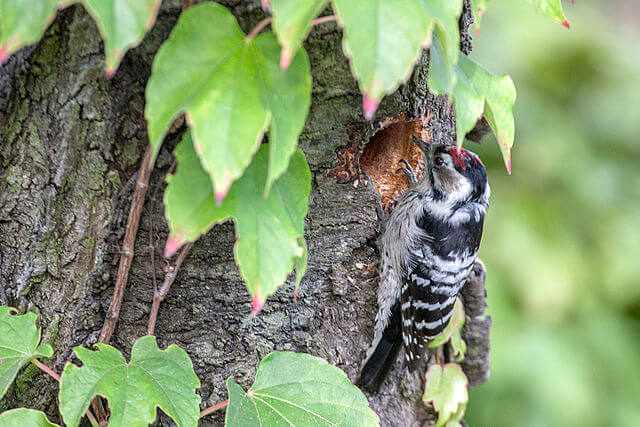
Woodland birds are facing an accelerating decline in the UK.
The UK is witnessing an alarming decline in woodland bird populations, with the risk of extinction looming unless immediate government intervention occurs, according to experts.
The Department for Environment, Food and Rural Affairs (Defra) has released data indicating a pervasive reduction in the abundance of nearly all bird species. Despite persistent warnings from environmental organisations about the urgent need to safeguard habitats and preserve species, the decline persists.
Woodland birds, in particular, are experiencing a critical situation, as their abundance indicator has plummeted by 37% since 1970 and 15% in the past five years, indicating an accelerating decline. Overall, bird indicators have fallen by 6% in the last five years and 15% since 1970. Within the woodland bird category, only three species—blackcap, nightingale, and nuthatch—have witnessed an increase in the past five years, while a staggering 23 have faced a decline.
The government attributes the decline in woodland birds to factors such as heightened deer browsing pressure, which diminishes foraging and nesting habitats, as well as the removal of hedgerows and deforestation, resulting in habitat loss. Defra emphasizes that the restoration of woodlands could positively impact these species.
Prof Richard Gregory, the head of monitoring at the RSPB Centre for Conservation Science, said: “Setting aside the seabirds, which have only been partially updated, all the bird trends are dipping downwards, most prominently among woodland birds.
“In the last five years, the index dropped by 15%; only three birds in the indicator have increased, compared to 23 that have declined. A range of factors weigh down on woodland birds and bird populations more generally, related primarily to land use and climate change.
“Willow tits prefer scrubby, often wet, woodlands with lots of variety so a decline in active woodland management over many years, with burgeoning deer populations browsing out the lower vegetation, means we are losing the scrubby under-storey they need, and added to that our soils are drying out with climate change, and woods are becoming more and more fragmented with development pressure.
“A similar set of factors are implicated in the downturn of the lesser spotted woodpecker, a bird that needs mature, open and varied woodland, and lots of it in the landscape scale. In this case, the reasons for decline are less clear, low breeding productivity due to food shortage has been suggested, as well as climate change impacts, competition with the larger great spotted woodpecker and increased nest predation, but their demise remains something of a mystery.”
While the decline in farmland bird populations is less pronounced at 8% in recent years, there has been a significant 60% drop since 1970, necessitating additional efforts for their conservation.
Vanessa Amaral-Rogers from the RSPB said: “Although the steepest rate of decline in the indicator was in the 1980s, it continues to this day, with a decline of 8% in the indicator in the last five years. This is not a situation without hope, however, with good evidence that well-designed and targeted higher tier agri-environment schemes can allow farmers to support species’ recovery alongside productive farming. Nevertheless, the best evidence suggests that in order to halt and start to reverse declines in the farmland bird indicator these schemes would need to be implemented on a much wider scale.”
The Royal Society for the Protection of Birds (RSPB) offers a glimmer of hope, pointing out that conservation efforts by charities have likely mitigated steeper declines. Interestingly, some extremely rare birds, such as the bittern and white-tailed eagle (with fewer than 500 pairs), are experiencing success due to dedicated conservation initiatives, highlighting the potential for positive outcomes with targeted efforts.
Gregory said: “Report after report tells us that nature can’t wait. We have the knowledge to turn things around, but evidence shows that our actions must be scaled up considerably to be effective and bend the curve of nature loss. We need the UK government to act urgently on its commitments to address wildlife decline, and for all politicians to stand up for nature while there is still time.”
A Defra spokesperson said: “Under the Environmental Improvement Plan, we set out clear steps to halt the decline in species abundance by 2030 and improve the status of wild birds and other species which play an important role in our ecosystems.
“We are already taking robust action to reduce key pressures on wild birds and improve their habitats. For example, our targeted species recovery efforts have helped to improve the conservation status of species such as the curlew and bittern – but we do not underestimate the scale of the challenge ahead.”
——————————————————————————
At Natural World Fund, we are passionate about stopping the decline in our wildlife.
The decline in our wildlife is shocking and frightening. Without much more support, many of the animals we know and love will continue in their decline towards extinction.
When you help to restore a patch of degraded land through rewilding to forests, meadows, or wetlands, you have a massive impact on the biodiversity at a local level. You give animals a home and food that they otherwise would not have had, and it has a positive snowball effect on the food chain.
We are convinced that this is much better for the UK than growing lots of fast-growing coniferous trees, solely to remove carbon, that don’t actually help our animals to thrive.
This is why we stand for restoring nature in the UK through responsible rewilding. For us, it is the right thing to do. Let’s do what’s right for nature!
Donate today at https://naturalworldfund.com/ and join in the solution!

